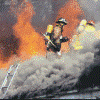
FEMA Awards $1 Million to Take Firefighting Technology to New Level
Worcester Polytechnic Institute (WPI) in Worcester, Mass., has received a one-year, $1 million award from the Federal Emergency Management Agency (FEMA) to develop the final component of an integrated monitoring system designed to reduce firefighter deaths and injuries. The system is designed to precisely locate and track firefighters inside buildings in three dimensions, continuously monitoring their vital signs to warn incident commanders when they are at risk of stress-related heart attacks, while also taking floor-to-ceiling temperature readings inside buildings to provide an early warning of impending flashover.
Work on the location and tracking and physiological monitoring components of the system began as a direct response to the 1999 Worcester Cold Storage Warehouse fire, in which six firefighters died when they became lost in dense smoke inside the mazelike, windowless structure. With more than $4 million in funding from the Department of Justice, the Department of Homeland Security, FEMA, and the U.S. Army, the WPI Precision Personnel Location (PPL) research team has developed and extensively tested a system that uses advanced radio frequency and radar technology to locate firefighters to within a few feet in three dimensions and display their locations and movements on a display screen at the incident commander's station. Physiological monitoring is provided by a wireless pulse oximeter developed by WPI researchers that is worn on the forehead and a sensor-embedded T-shirt made by Foster-Miller. Physiological information is integrated into the incident commander's display.
With the FEMA award, the PPL team, which consists of faculty members and students in WPI's Electrical and Computer Engineering Department, will work with researchers in the university's Fire Protection Engineering Department and engineers at the National Institute of Standards and Technology (NIST) and QinetiQ North America/Foster-Miller to develop an inexpensive, portable, disposable wireless sensor array called the Fireground Environment Sensor Monitoring (ESM) System that can be carried into a building and placed in selected rooms by firefighters. Once in place, the device will deploy a mast that will rise to the ceiling. The mast will have temperature sensors every 30 centimeters and a heat flux sensor in its base.
Data from the sensors will be transmitted to the incident command station where it will be processed by custom-designed algorithms. The risk of extreme heat stress and time to flashover (the point when all combustible materials in a room simultaneously erupt in flames) will be displayed on the incident commander's screen, along with the firefighters' locations and vital signs. The WPI researchers estimate that the system will extend the warning time firefighters have of pending flashover from about 8 seconds (with modern heat-resistant gear, firefighters often don't sense extreme heat until it is too late) to well over a minute.
The ESM is designed to help lower the incidence of injuries (particularly burns) related to extreme temperatures and flashover. It will also help incident commanders plan an attack on a developing fire using the right number of firefighters and the safest and most effective route and better plan rescue missions for civilians and downed firefighters. With the addition of the new device, the WPI monitoring system will help address all three of the primary causes of firefighter fatalities: stress-related heart attacks, traumatic injuries, and becoming lost or disabled inside burning structures. "The prediction of the time to flashover will give the incident commander a critical piece of information that, when combined with the location of each firefighter, will greatly enhance the natural decision making process," said Kathy Notarianni, associate professor and head of the WPI's Department of Fire Protection Engineering.
The heat flux sensor for the ESM will be developed by WPI engineers, while the team at QinetiQ North America/Foster-Miller will develop the deployable temperature sensor mast. Initial testing of the system will be conducted in the burn chamber in WPI's fire science laboratory. Larger-scale tests will be conducted in the large burn building at the Massachusetts Firefighting Academy in Stow, Mass. Results of the tests will be evaluated with fire models developed by WPI's Fire Protection Engineering Department and NIST to determine and fine-tune algorithms for predicting the risk of flashover. The Worcester Fire Department will assist with the integration of the temperature data and flashover risk information into the existing incident command display developed by the WPI PPL team.
"Firefighting technology has always been borrowed from other fields," said David Cyganski, professor of electrical and computer engineering at WPI and a member of the PPL research team. "New important advances for saving firefighters will come from projects like this that address their specific needs directly."
James Duckworth, associate professor of electrical and computer engineering, added, "We believe this work will help provide firefighters with the necessary technology to ensure that there is not a repeat of the 1999 warehouse fire tragedy."